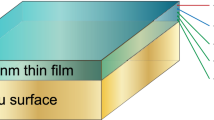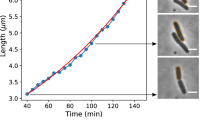Abstract
Attachment tendencies of Escherichia coli K12, Pseudomonas aeruginosa ATCC 9027, and Staphylococcus aureus CIP 68.5 onto glass surfaces of different degrees of nanometer-scale roughness have been studied. Contact-angle and surface-charge measurements, atomic force microscopy (AFM), scanning electron microscopy (SEM), and confocal laser scanning microscopy (CLSM) were employed to characterize substrata and bacterial surfaces. Modification of the glass surface resulted in nanometer-scale changes in the surface topography, whereas the physicochemical characteristics of the surfaces remained almost constant. AFM analysis indicated that the overall surface roughness parameters were reduced by 60–70%. SEM, CLSM, and AFM analysis clearly demonstrates that although E. coli, P. aeruginosa and S. aureus present significantly different patterns of attachment, all of the species exhibited a greater propensity for adhesion to the “nano-smooth” surface. The bacteria responded to the surface modification with a remarkable change in cellular metabolic activity, as shown by the characteristic cell morphologies, production of extracellular polymeric substances, and an increase in the number of bacterial cells undergoing attachment.



Similar content being viewed by others
References
Advincula MA, Petersen D, Rahemtulla F et al (2007) Surface analysis and biocorrosion properties of nanostructured surface sol-gel coatings on Ti6Al4v titanium alloy implants. J Biomed Mater Res B Appl Biomater 80:107–120
Bakker DP, Busscher HJ, van der Mei HC (2002) Bacterial deposition in a parallel plate and a stagnation point flow chamber: microbial adhesion mechanisms depend on the mass transport conditions. Microbiology 148:597–603
Bos R, van der Mei HC, Busscher HJ (1999) Physico-chemistry of initial microbial adhesive interactions: its mechanisms and methods for study. FEMS Microbiol Rev 23:179–230
Bruinsma GM, Rustema-Abbing M, van der Mei HC et al (2001) Effects of cell surface damage on surface properties and adhesion of Pseudomonas aeruginosa. J Microbiol Methods 45:95–101
Burks GA, Velegol SB, Paramonova E et al (2003) Macroscopic and nanoscale measurements of the adhesion of bacteria with varying outer layer surface composition. Langmuir 19:2366–2371
Busscher HJ, Norde W (2000) Limiting values for bacterial ζ potentials. J Biomed Mater Res 50:463–464
Canepari P, Boaretti M, Lleó MM et al (1990) Lipoteichoic acid as a new target for activity of antibiotics: mode of action of daptomycin (ly146032). Antimicrob Agents Chemother 34:1220–1226
Chae MS, Schraft H, Truelstrup Hansen L et al (2006) Effects of physicochemical surface characteristics of Listeria monocytogenes strains on attachment to glass. Food Microbiol 23:250–259
Dong H, Onstotta TC, Kob C-HA et al (2002) Theoretical prediction of collision efficiency between adhesion-deficient bacteria and sediment grain surface. Colloids Surfaces B: Biointerfaces 24:229
Eboigbodin EK, Newton ARJ, Routh FA et al (2006) Bacterial quorum sensing and cell surface electrokinetic properties. Appl Microbiol Biotechnol 73:669–675
Emerson RJ, Bergstrom TS, Liu Y et al (2006) Microscale correlation between surface chemistry, texture, and the adhesive strength of Staphylococcus epidermidis. Langmuir 22:11311–11321
Gottenbos B, Grijpma DW, Van der Mei CH et al (2001) Antimicrobial effects of positively charged surfaces on adhering gram-positive and gram-negative bacteria. J Antimicrob Chemother 48:7–13
Gross M, Cramton SE, Gotz F et al (2001) Key role of teichoic acid net charge in Staphylococcus aureus colonization of artificial surfaces. Infect Immun 69:3423–3426
Howell D, Behrends B (2006) A review of surface roughness in antifouling coatings illustrating the importance of cutoff length. Biofouling 22:401–410
Korenevsky A, Beveridge TJ (2007) The surface physicochemistry and adhesiveness of Shewanella are affected by their surface polysaccharides. Microbiology 153:1872–1883
Mandlik A, Swierczynski A, Das A et al (2008) Pili in gram-positive bacteria: assembly, involvement in colonization and biofilm development. Trends Microbiol 16:33–40
Mitik-Dineva N, Wang J, Mocanasu CR et al (2008) Impact of nano-topography on bacterial attachment. Biotechnol J 3:536–544
O’Toole GA, Kolter R (1998) Flagellar and twitching motility are necessary for pseudomonas aeruginosa biofilm development. Mol Microbiol 30:295–304
Öner D, McCarthy TJ (2000) Ultrahydrophobic surfaces. Effects of topography length scales on wettability. Langmuir 16:7777–7782
Petronis S, Berntsson K, Gold J et al (2000) Design and microstructuring of PDMS surfaces for improved marine biofouling resistance. J Biomater Sci Polym Ed 11:1051–1072
Quéré D, Lafuma A, Bico J (2003) Slippy and sticky microtextured solids. Nanotechnology 14:1109–1112
Riedewald F (2006) Bacterial adhesion to surfaces: the influence of surface roughness. PDA J Pharma Sci Technol 60:164–171
Scardino AJ, Harvey E, De Nys R (2006) Testing attachment point theory: diatom attachment on microtextured polyimide biomimics. Biofouling 22:55–60
Shellenberger K, Logan BE (2002) Effect of molecular scale roughness of glass beads on colloidal and bacterial deposition. Environ Sci Technol 36:184–189
Soni KA, Balasubramanian AK, Beskok A et al (2007) Zeta potential of selected bacteria in drinking water when dead, starved, or exposed to minimal and rich culture media. Curr Microbiol 56:93–97
Vadillo-Rodriguez V, Busscher HJ, Norde W et al (2004) Atomic force microscopy corroboration of bond aging for adhesion of Streptococcus thermophilus to solid substrata. J Colloid Interface Sci 278:251–254
van der Mei HC, Busscher HJ (2001) Electrophoretic mobility distributions of single-strain microbial populations. Appl Environ Microbiol 67:491–494
White JD, Stoddart RP (2005) Nanostructured optical fiber with surface-enhanced Raman scattering functionality. Opt Lett 30:598–600
Whitehead AK, Verran J (2006) The effect of surface topography on the retention of microorganisms. Food Bioprod Process 84:253–259
Acknowledgments
This study was supported in part by Australian Research Council (ARC).
Author information
Authors and Affiliations
Corresponding author
Rights and permissions
About this article
Cite this article
Mitik-Dineva, N., Wang, J., Truong, V.K. et al. Escherichia coli, Pseudomonas aeruginosa, and Staphylococcus aureus Attachment Patterns on Glass Surfaces with Nanoscale Roughness. Curr Microbiol 58, 268–273 (2009). https://doi.org/10.1007/s00284-008-9320-8
Received:
Revised:
Accepted:
Published:
Issue Date:
DOI: https://doi.org/10.1007/s00284-008-9320-8




